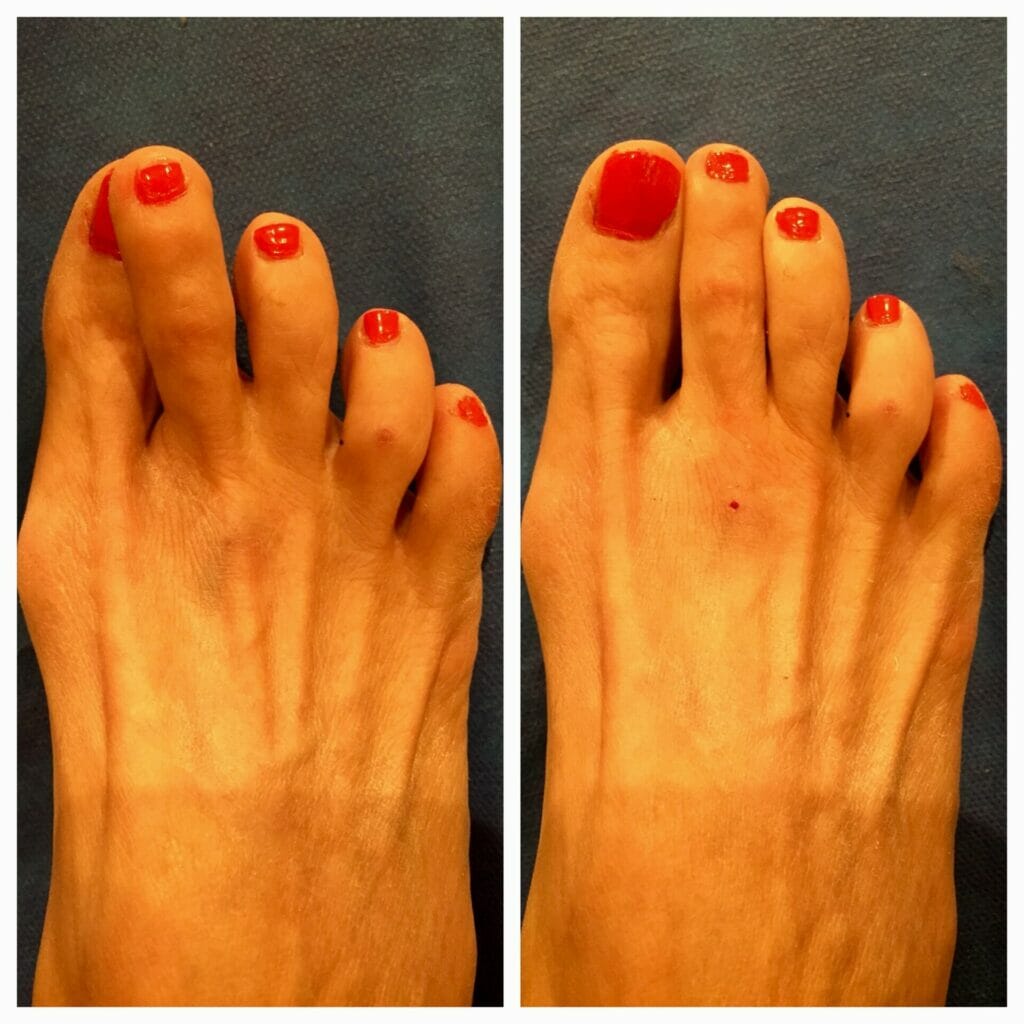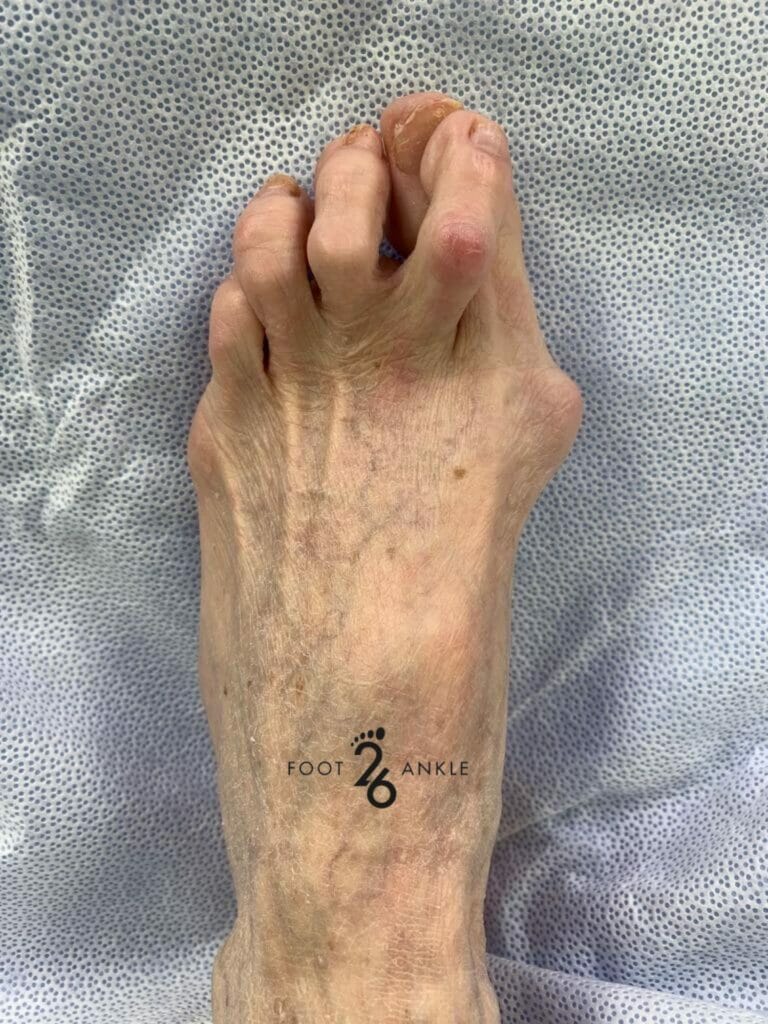The 26 Review
- What is Crossover Toe A severe contracture of the 2nd and sometimes 3rd toe that overlaps the big toe
- Causes Genetics, bunions, injury, ill-fitting shoes, and weakened ligaments surrounding the 2nd toe joint
- Symptoms 2nd toe pain including sores on top of the crossed toe
- Diagnosis Physical examination, physician experience, X-ray
- Treatment Gel pads and splints, hammertoe socks, shoe modifications, orthotics, surgery

Let’s take a closer look…
Crossover toe is a hammertoe variant. This deformity affects both the metatarsophalangeal joint (MPJ) and the proximal interphalangeal joint. We typically see this occur with the 2nd toe overlapping the big toe and occasionally involves the 3rd toe as well. Although this condition can affect people of all ages, it most commonly affects women after age 50. This ailment can affect people mildly, moderately, and severely.
Patients who have noticed the shifting of their second toe should consider taking preventative measures. If one should consider initial conservative treatments, they can include wide/deep toe box shoes, splinting, padding, and orthotics. In certain cases, conservative efforts may not work, and patients could run the risk of developing a severe case of crossover toe. When crossover toe deformities progress and pain persists, consider speaking with a podiatrist to discuss surgical options.
Causes
Crossover toe can occur for many different reasons and may be associated with one or more causes. Generally, crossover toe is caused when the ligaments surrounding the joint of the second toe become inflamed and weakened over time, eventually decreasing the ability to support and stabilize the toe. This results in a 2nd toe that drifts from its normal position onto the top of the big toe.
In most cases, crossover toe can be explained solely by abnormal foot structure that places significant stress on the 2nd toe; however, there are many other reasons for cases of crossover toe. Sometimes, people are born with a hereditary predisposition that will develop over time. In other instances, shoe gear is the external factor that can lead to crossover toe.\
High heels, in particular, cause excessive pressure on the ball of the foot, leading to injury and the destabilization of structures in the toe. If the plantar plate (ligament under the toe) becomes injured, it can lead to a cascade of instability and, ultimately, to a crossover toe. Some patients may develop crossover toes just from a bunion located on the big toe. A deformed toe often develops over time, and certain people may be predisposed.
Symptoms
Patients struggling with crossover toes should be able to observe visible signs, as well as should experience physical symptoms. Due to the nature of the ailment, pain may develop in the entire digit, on top and tip of the toe, and/or on the ball of the foot.
Wearing ill-fitting shoes when struggling with a crossover toe can cause excessive pressure. The result of this pressure is the potential formation of corns or calluses on the knuckle and/or ball of the foot. The toe(s) might become irritated, red, warm, and/or swollen.
As mentioned previously, crossover toes can be mild, moderate, and severe. Depending on the severity of the case, it can also determine whether the pain felt is dull and mild or severe and sharp. Pain is typically made worse by wearing shoes, specifically shoes that crowd the toes.
Although some crossover toes cause significant pain, certain patients may not deal with physical pain at all. Patients may be more likely to develop crossover toe if they have symptoms of other toe conditions like bunions or big toe joint arthritis.
Diagnosis
Diagnosis of crossover toe truly comes down to physical examination. X-rays may be utilized to determine the severity of the crossover and how to treat it best. Some common reasons patients should seek treatment include toe pain on the knuckle, thick toe calluses or open sores, pain when walking, difficulty fitting shoes, worsening toe deformity, pain at the ball of the foot, and unsightly appearance.
Crossover toe deformities come in varying degrees of severity. In certain cases, the toe can dislocate from the top of the foot. Depending on a patient’s overall health, symptoms, and severity of crossover toe, this condition can be treated conservatively or with surgery.

Treatment
Patients struggling with crossover toe have many options when it comes to treatment. Non-surgical methods for crossover toe are typically geared toward decreasing symptoms and/or preventing progression. Some simple treatments patients can try are wearing supportive shoes, using arch supports, wearing shoes with a wide toe box, modifying activities, spot stretching shoes, anti-inflammatory medicines, and periodic callus care.
Physical therapy has been recommended for crossover toe patients previously as it aids in strengthening poorly functioning muscles and stretches tight muscles. In combination with physical therapy, special ultrasound techniques can help reduce inflammation.
Custom foot orthotics better align and support the foot, providing comfort and preventing future progression. For patients with more moderate symptoms, splints or pads can prevent pressure and physical irritation in shoes. Toe splints, toe spacers, and hammertoe socks physically realign the toes, lessen pain, and stall crossover toe progression.
The last non-surgical treatment is injections. Cortisone injections are strong anti-inflammatory agents that decrease pain and swelling. However, these injections only treat symptoms. As mentioned, crossover toes can be surgically fixed. Several surgical methods can be used depending on the toe’s severity and length.
In short, crossover toe surgery involves removing a portion of the toe bone at the contracted joint and relocating the toe at the ball of the foot while aligning the toe. In some cases, amputation of the crossover toe may be the best option when a quick return to normal activities is desired. Speaking with a medical professional about your options can help you better determine whether conservative treatments or surgery are right for you.